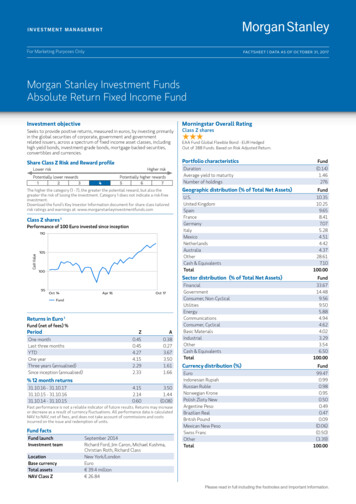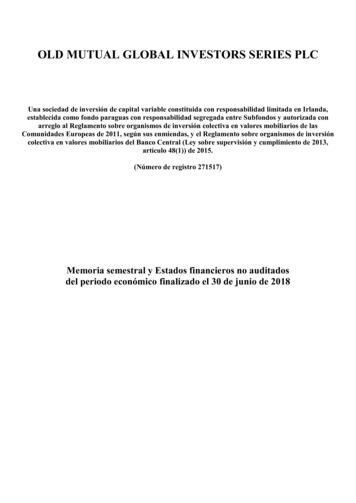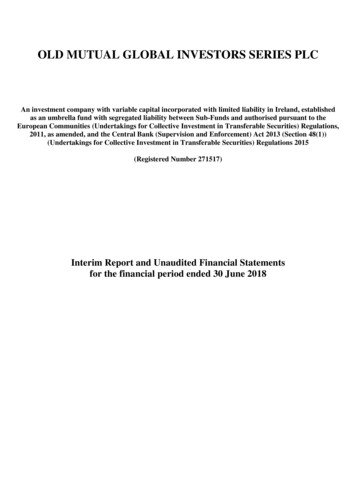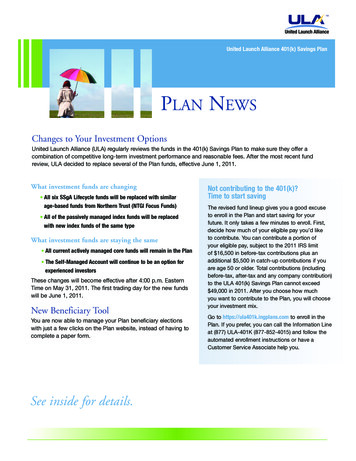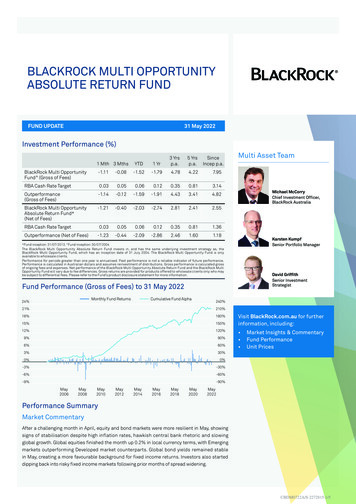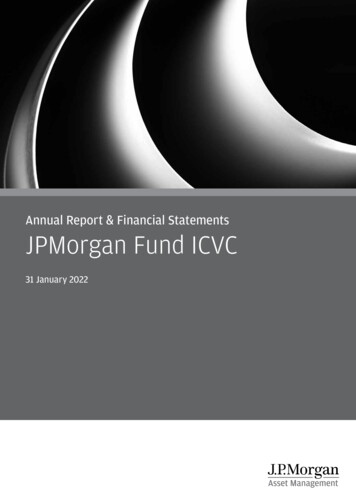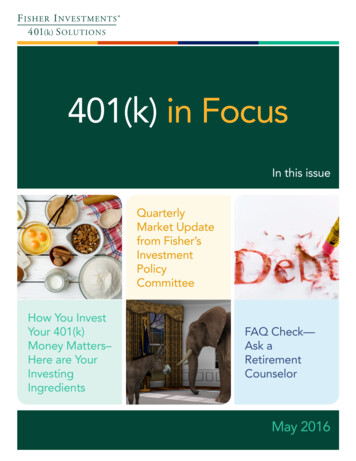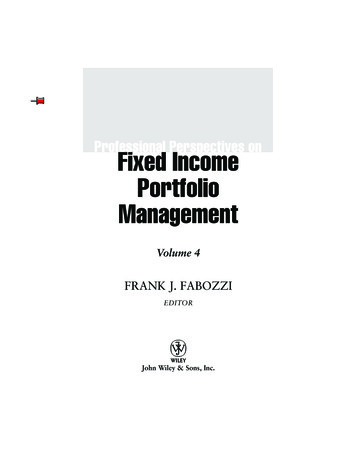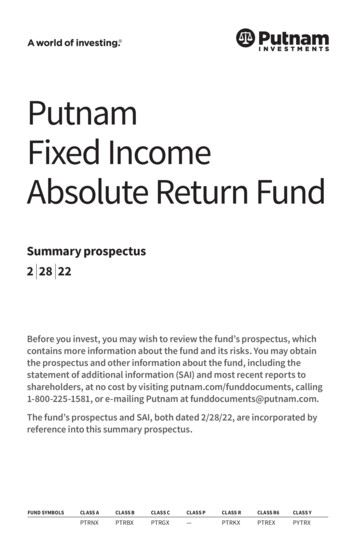
Transcription
PutnamFixed IncomeAbsolute Return FundSummary prospectus2 28 22Before you invest, you may wish to review the fund’s prospectus, whichcontains more information about the fund and its risks. You may obtainthe prospectus and other information about the fund, including thestatement of additional information (SAI) and most recent reports toshareholders, at no cost by visiting putnam.com/funddocuments, calling1-800-225-1581, or e-mailing Putnam at funddocuments@putnam.com.The fund’s prospectus and SAI, both dated 2/28/22, are incorporated byreference into this summary prospectus.FUND SYMBOLSCLASS ACLASS BCLASS CCLASS PCLASS RCLASS R6CLASS YPTRNXPTRBXPTRGX—PTRKXPTREXPYTRX
Putnam Fixed Income Absolute Return FundGoalPutnam Fixed Income Absolute Return Fund seeks positive total return.Fees and expensesThe following tables describe the fees and expenses you may pay if you buy, hold and sellshares of the fund. You may pay other fees, such as brokerage commissions and other feesto financial intermediaries, which are not reflected in the tables and examples below. Youmay qualify for sales charge discounts if you and your family invest, or agree to invest in thefuture, at least 100,000 in Putnam funds. More information about these and other discountsis available from your financial professional and in How do I buy fund shares? beginning onpage 23 of the fund’s prospectus, in the Appendix to the fund’s prospectus, and in How tobuy shares beginning on page II-1 of the fund’s statement of additional information (SAI).Shareholder fees (fees paid directly from your investment)Share classMaximum sales charge (load)imposed on purchases (as apercentage of offering price)Maximum deferred sales charge(load) (as a percentage of originalpurchase price or redemption proceeds,whichever is lower)Class AClass BClass CClass PClass RClass R6Class *NONENONENONENONEAnnual fund operating expenses(expenses you pay each year as a percentage of the value of your investment)Share classManagement feesClass AClass BClass CClass PClass RClass R6Class nand service (12b-1)feesOtherexpenses Total annualfund %1.02%0.52%0.52%* Applies only to certain redemptions of shares bought with no initial sales charge.** This charge is phased out over two years.*** This charge is eliminated after one year.† Management fees are subject to a performance adjustment. The fund’s base management fee is subject toadjustment, up or down, based on the fund’s performance relative to the performance of the ICE BofA U.S.Treasury Bill Index plus 300 basis points. For the most recent fiscal year, the fund’s base management feeprior to any performance adjustment was 0.60%. Other expenses are less than 0.01%.ExampleThe following hypothetical example is intended to help you compare the cost of investing inthe fund with the cost of investing in other funds. It assumes that you invest 10,000 in thefund for the time periods indicated and then, except as indicated, redeem all your shares at2
the end of those periods. It assumes a 5% return on your investment each year and that thefund’s operating expenses remain the same. Your actual costs may be higher or lower.Share class1 year3 years5 years10 yearsClass AClass BClass B (no redemption)Class CClass C (no redemption)Class PClass RClass R6Class Y 302 199 99 255 155 53 104 53 53 465 309 309 480 480 167 325 167 167 643 536 536 829 829 291 563 291 291 1,158 1,133 1,133 1,610 1,610 653 1,248 653 653Portfolio turnoverThe fund pays transaction-related costs, such as commissions, when it buys and sellssecurities (or “turns over” its portfolio). A higher turnover rate may indicate higher transactioncosts and may result in higher taxes when the fund’s shares are held in a taxable account.These costs, which are not reflected in annual fund operating expenses or the above example,affect fund performance. The fund’s turnover rate in the most recent fiscal year was 908%.Investments, risks, and performanceInvestmentsThe fund is designed to pursue a consistent absolute return through a broadly diversifiedportfolio reflecting uncorrelated fixed-income strategies designed to exploit marketinefficiencies across global markets and fixed-income sectors. These strategiesinclude investments in the following asset categories: (a) sovereign debt: obligationsof governments in developed and emerging markets; (b) corporate credit: investmentgrade debt, below-investment-grade debt (sometimes referred to as “junk bonds”), bankloans, convertible bonds and structured credit; and (c) securitized assets: asset-backedsecurities, residential mortgage-backed securities (which may be backed by non-qualifiedor “sub-prime” mortgages), commercial mortgage-backed securities, collateralizedloan obligations (“CLOs”), and collateralized mortgage obligations. The fund currentlyhas significant investment exposure to residential and commercial mortgage-backedinvestments. In pursuing a consistent absolute return, the fund’s strategies are alsogenerally intended to produce lower volatility over a reasonable period of time than hasbeen historically associated with traditional asset classes that have earned similar levelsof return over long historical periods. These traditional asset classes might include, forexample, bonds with moderate exposure to interest rate and credit risks.Under normal circumstances, the fund will invest at least 80% of its net assets in fixed-incomesecurities (fixed-income securities include any debt instrument, and may be represented byother investment instruments, including derivatives). This policy may be changed only after 60days’ notice to shareholders. We may consider, among other factors, credit, interest rate andprepayment risks, as well as general market conditions, when deciding whether to buy or sellinvestments. We typically use derivatives, such as futures, options, certain foreign currencytransactions, warrants and swap contracts, for both hedging and non-hedging purposes.Accordingly, we may use derivatives to a significant extent to obtain or enhance exposure tothe fixed-income sectors and strategies mentioned above, and to hedge against risk.RisksIt is important to understand that you can lose money by investing in the fund. 3
Our allocation of assets among fixed-income strategies and sectors may hurt performance,and our efforts to diversify risk through the use of leverage and allocation decisions maynot be successful. If the quantitative models or data that are used in managing the fundprove to be incorrect or incomplete, investment decisions made in reliance on the modelsor data may not produce the desired results and the fund may realize losses.The value of investments in the fund’s portfolio may fall or fail to rise over extended periodsof time for a variety of reasons, including general economic, political or financial marketconditions, investor sentiment and market perceptions, government actions, geopoliticalevents or changes, and factors related to a specific issuer, geography, industry or sector. Theseand other factors may lead to increased volatility and reduced liquidity in the fund’s portfolioholdings. The novel coronavirus (COVID-19) pandemic and efforts to contain its spread arelikely to negatively affect the value, volatility, and liquidity of the securities and other assets inwhich the fund invests and exacerbate other risks that apply to the fund. These effects couldnegatively impact the fund’s performance and lead to losses on your investment in the fund.Bond investments are subject to interest rate risk, which is the risk that the value of thefund’s bond investments is likely to fall if interest rates rise. Bond investments also aresubject to credit risk, which is the risk that the issuer of the bond may default on paymentof interest or principal. Bond investments may be more susceptible to downgrades ordefaults during economic downturns or other periods of economic stress. Interest raterisk is generally greater for longer-term bonds, and credit risk is generally greater forbelow-investment-grade bonds, which may be considered speculative. Mortgage-backedinvestments, unlike traditional debt investments, are also subject to prepayment risk,which means that they may increase in value less than other bonds when interest ratesdecline and decline in value more than other bonds when interest rates rise. We may haveto invest the proceeds from prepaid investments, including mortgage- and asset-backedinvestments, in other investments with less attractive terms and yields.The fund’s investments in mortgage-backed investments, CLOs, and in certain other securitiesand derivatives, may be or become illiquid. The fund currently has significant investmentexposure to privately issued residential and commercial mortgage-backed securities andmortgage-backed securities issued or guaranteed by the U.S. government or its agencies orinstrumentalities, which may make the fund’s net asset value more susceptible to economic,market, political and other developments affecting the residential and commercial real estatemarkets and the servicing of mortgage loans secured by real estate properties. During periodsof difficult economic conditions, delinquencies and losses on commercial mortgage-backedinvestments in particular generally increase, including as a result of the effects of thoseconditions on commercial real estate markets, the ability of commercial tenants to make loanpayments, and the ability of a property to attract and retain commercial tenants.The fund’s investments in CLOs, which are obligations of a trust or other special purposevehicle typically collateralized by a pool of loans, bear many of the same risks as mortgagebacked securities and other forms of asset-backed securities. These risks include interest rate,prepayment, credit, liquidity and market risks. The degree of these risks varies depending onthe type of underlying assets and the specific tranche in which the fund is invested. In addition,due to the complex nature of securitized assets (including CLOs and mortgage-backedinvestments), an investment in securitized assets may not perform as expected.The value of international investments traded in foreign currencies may be adversely impactedby fluctuations in exchange rates. International investments, particularly investments inemerging markets, may carry risks associated with potentially less stable economies orgovernments (such as the risk of seizure by a foreign government, the imposition of currencyor other restrictions, or high levels of inflation), and may be or become illiquid. Our use ofderivatives may increase the risks of investing in the fund by increasing investment exposure(which may be considered leverage) or, in the case of many over‑the‑counter instruments,4
because of the potential inability to terminate or sell derivatives positions and the potentialfailure of the other party to the instrument to meet its obligations.There is no guarantee that the investment techniques, analyses, or judgments that weapply in making investment decisions for the fund will produce the intended outcome orthat the investments we select for the fund will perform as well as other securities thatwere not selected for the fund. We, or the fund’s other service providers, may experiencedisruptions or operating errors that could negatively impact the fund.The fund may not achieve its goal, and it is not intended to be a complete investmentprogram. The fund’s efforts to produce lower volatility returns may not be successful.An investment in the fund is not insured or guaranteed by the Federal Deposit InsuranceCorporation or any other government agency.PerformanceThe performance information below gives some indication of the risks associated withan investment in the fund by showing the fund’s performance year to year and over time.The bar chart does not reflect the impact of sales charges. If it did, performance would belower. Please remember that past performance is not necessarily an indication of futureresults. Monthly performance figures for the fund are available at putnam.com.Annual total returns for class A shares before sales 1.91%201220132014201520162017201820192020Best calendarquarterQ2 20204.50%Worst calendarquarterQ1 2020–7.55%–3.85%2021Average annual total returns after sales charges (for periods ended 12/31/21)Share class1 year5 years10 yearsClass A before taxesClass A after taxes on distributionsClass A after taxes on distributions and saleof fund sharesClass B before taxesClass C before taxesClass P before taxes*Class R before taxesClass R6 before taxes*Class Y before taxesICE BofA U.S. Treasury Bill 1.54%3.57%2.90%18.47%16.55%(no deduction for fees, expenses or taxes)ICE BofA U.S. Treasury Bill Index plus300 basis points (no deduction for fees,expenses or taxes)Bloomberg U.S. Aggregate Bond Index†(no deduction for fees, expenses or taxes)S&P 500 Index (no deduction for fees, expensesor taxes)28.71% 5
* Performance for class R6 shares prior to their inception (7/2/12) and for class P shares prior to their inception(8/31/16) is derived from the historical performance of class Y shares.ICE BofA Indexes: ICE Data Indices, LLC (“ICE BofA”), used with permission. ICE BofA permits use of theICE BofA indices and related data on an “as is” basis; makes no warranties regarding same; does notguarantee the suitability, quality, accuracy, timeliness, and/or completeness of the ICE BofA indicesor any data included in, related to, or derived therefrom; assumes no liability in connection with theuse of the foregoing; and does not sponsor, endorse, or recommend Putnam Investments, or any of itsproducts or services.After-tax returns reflect the historical highest individual federal marginal income tax rates and do notreflect state and local taxes. Actual after-tax returns depend on an investor’s tax situation and may differfrom those shown. After-tax returns are shown for class A shares only and will vary for other classes. Theseafter-tax returns do not apply if you hold your fund shares through a 401(k) plan, an IRA, or another taxadvantaged arrangement.Class B and C share performance reflects conversion to class A shares after eight years.ICE BofA U.S. Treasury Bill Index tracks the performance of U.S. dollar denominated U.S. Treasury bills,which represent obligations of the U.S. Government having a maturity of one year or less, and is intended asan approximate measure of the rate of inflation. ICE BofA U.S. Treasury Bill Index 3.00% is the benchmarkand hurdle rate for the performance adjustment component of the fund’s management fee.The Bloomberg U.S. Aggregate Bond Index and the S&P 500 Index are broad measures of marketperformance. Securities in the fund do not match those in the indexes and the performance of thefund will differ.† Source: Bloomberg Index Services Limited.BLOOMBERG is a trademark and service mark of Bloomberg Finance L.P. and its affiliates (collectively“Bloomberg”). Bloomberg or Bloomberg’s licensors own all proprietary rights in the Bloomberg Indices.Neither Bloomberg nor Bloomberg’s licensors approve or endorse this material or guarantee the accuracyor completeness of any information herein, or make any warranty, express or implied, as to the resultsto be obtained therefrom and, to the maximum extent allowed by law, neither shall have any liability orresponsibility for injury or damages arising in connection therewith.Your fund’s managementInvestment advisorPutnam Investment Management, LLCPortfolio managersMichael SalmChief Investment Officer, Fixed Income,portfolio manager of the fund since 2008Norman Boucher*Portfolio Manager, portfolio manager ofthe fund since 2022Albert ChanHead of Portfolio Construction, portfoliomanager of the fund since 2017Paul Scanlon**Co-Head of Corporate and Tax-exemptCredit, portfolio manager of the fundsince 2008* Norman Boucher will become a portfolio manager of the Fund effective March 31, 2022.** Paul Scanlon, who is currently a portfolio manager of the fund, will retire as a portfolio manager of the Fundeffective March 31, 2022.Sub-advisorsPutnam Investments Limited***The Putnam Advisory Company, LLC****** Though the investment advisor has retained the services of both Putnam Investments Limited (PIL) andThe Putnam Advisory Company, LLC (PAC), PIL and PAC do not currently manage any assets of the fund.6
Purchase and sale of fund sharesYou can open an account, purchase and/or sell fund shares, or exchange them for sharesof another Putnam fund by contacting your financial professional or by calling PutnamInvestor Services at 1-800-225-1581. Purchases of class B shares are closed to new andexisting investors except by exchange from class B shares of another Putnam fund orthrough dividend and/or capital gains reinvestment.When opening an account, you must complete and mail a Putnam account application,along with a check made payable to the fund, to: Putnam Investments, P.O. Box 219697,Kansas City, MO 64121-9697. The minimum initial investment of 500 is currently waived,although Putnam reserves the right to reject initial investments under 500 at itsdiscretion. There is no minimum for subsequent investments.Class P shares are only available to other Putnam funds and other accounts managed byPutnam Management or its affiliates.You can sell your shares back to the fund or exchange them for shares of another Putnamfund any day the New York Stock Exchange (NYSE) is open. Shares may be sold orexchanged by mail, by phone, or online at putnam.com. Some restrictions may apply.Tax informationThe fund’s distributions will be taxed as ordinary income or capital gains unless you holdthe shares through a tax-advantaged arrangement, in which case you will generally betaxed only upon withdrawal of monies from the arrangement.Financial intermediary compensationIf you purchase the fund through a broker/dealer or other financial intermediary (suchas a bank or financial professional), the fund and its related companies may pay thatintermediary for the sale of fund shares and related services. Please bear in mind thatthese payments may create a conflict of interest by influencing the broker/dealer or otherintermediary to recommend the fund over another investment. Ask your advisor or visityour advisor’s website for more information.Information about the Summary Prospectus, Prospectus, and SAIThe summary prospectus, prospectus, and SAI for a fund provide information concerningthe fund. The summary prospectus, prospectus, and SAI are updated at least annually, andany information provided in a summary prospectus, prospectus, or SAI can be changedwithout a shareholder vote unless specifically stated otherwise. The summary prospectus,prospectus and the SAI are not contracts between the fund and its shareholders and do notgive rise to any contractual rights or obligations or any shareholder rights other than anyrights conferred explicitly by federal or state securities laws that may not be waived.Additional information, including current performance, is available atputnam.com/funddocuments, by calling 1-800-225-1581, or by e-mailingPutnam at funddocuments@putnam.com. 7
BP109 328731 2/22 Putnam Retail Management
which the fund invests and exacerbate other risks that apply to the fund. These effects could negatively impact the fund's performance and lead to losses on your investment in the fund. Bond investments are subject to interest rate risk, which is the risk that the value of the fund's bond investments is likely to fall if interest rates rise.
